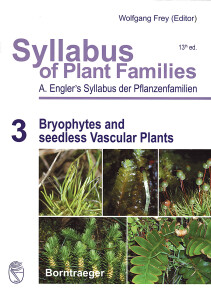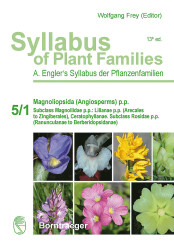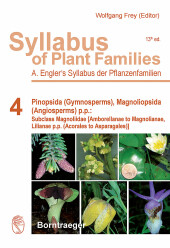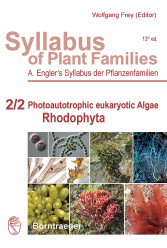Syllabus of Plant Families - A. Engler's Syllabus der Pflanzenfamilien Part 3 (2009)-Adolf Engler
2 269,09 Kč vč. DPH
2 269,09 Kč bez DPH
Marchantiophyta, Bryophyta, Anthocerotophyta, Protracheophyta (Horneophytopsida), Tracheophyta p.p.: Rhyniophytina, Lycophytina, Trimerophytina, Moniliformopses (Pteridophyta), Radiatopses (Progymnospermopsida)
|
Country | % VAT (books) | % VAT | |
|---|---|---|---|
| DEU | 7 | 19 | |
| HUN | 5 | 27 | |
| AUT | 10 | 20 | |
| BEL | 6 | 21 | |
| BGR | 9 | 20 | |
| DNK | 25 | 25 | |
| EST | 9 | 20 | |
| FIN | 10 | 24 | |
| FRA | 5,5 | 20 | |
| HRV | 5 | 25 | |
| IRL | 0 | 23 | |
| ITA | 4 | 22 | |
| CYP | 5 | 19 | |
| LTU | 9 | 21 | |
| LVA | 5 | 21 | |
| LUX | 3 | 16 | |
| MLT | 5 | 18 | |
| NLD | 9 | 21 | |
| POL | 5 | 23 | |
| PRT | 6 | 23 | |
| ROU | 5 | 19 | |
| GRC | 6 | 24 | |
| SVK | 10 | 20 | |
| SVN | 5 | 22 | |
| ESP | 7 | 21 | |
| SWE | 6 |
25 |
Cena platí pouze pro české zákazníky. Vzhledem k novému nařízení Evropského parlamentu musí být konečná cena od 1. července 2021 kalkulována podle země konečného určení. Platnou sazbu DPH ve vaší zemi naleznete v tabulce výše.
https://ec.europa.eu/taxation_customs
Záruka (měsíce): 24
Dostupnost: Do 14 dnů
2009. 13. edition, VIII, 419 pages, 72 figures, 17x25cm, 1140 g
Language: English
Part 3 of Engler's Syllabus of Plant Families - "Bryophytes and seedless Vascular Plants" provides a thorough treatment of the world-wide morphological and molecular diversity of a part of "lower" plants [Marchantiophyta, Bryophyta, Anthocerotophyta, Polysporangiomorpha, Protracheophytes, Rhyniophytina, Lycophytina, "Trimerophytina", Moniliformopses (Cladoxylopsida, Psilotopsida, Equisetopsida, Marattiopsida, Polypodiopsida)], and Radiatopses (Progymnospermopsida).
The advent of DNA sequencing and advances in phylogenetic analysis has raised new interest in the relationships of liverworts, mosses, hornworts, ferns, and fern allies as extant representatives of early land plant evolution. Following the tradition of Engler with the morphological-anatomical data and incorporating latest results from molecular phylogenetics and phylogenomics, an up-to-date overview of families and genera has been created that will serve as reference for a long time.
Engler's Syllabus of Plant Families has since its first publication in 1887 aimed to provide both the researcher, and particularly the student with a concise survey of the plant kingdom as a whole, presenting all higher systematic units right down to families and genera of plants and fungi. In 1964, more than 40 years ago, the 12th edition of the well-known "Syllabus der Pflanzenfamilien" ("Syllabus of Plant Families"), set a standard.
Now, the completely restructured and revised 13th edition of Engler's Syllabus published in 5 parts and in English language, for the fi rst time also considers molecular data, which have only recently become available in order to provide an up-to-date evolutionary and systematic overview of the plant groups treated.
In our "molecular times" there is a growing need to preserve the knowledge of the entire range of diversity and biology of organisms for coming generations, as there is a decline in "classical" morphological and taxonomical expertise, especially for less popular (showy) groups of organisms. Accordingly, the 13th edition of Syllabus of Plant Families synthesizes both modern data and classical expertise, serving to educate future experts who will maintain our knowledge of the full range of Earth's biodiversity.
Syllabus of Plant Families is a mandatory reference for students, experts and researchers from all fields of biological sciences, particularly botany.
Abbreviations, Symbols II
1 Introduction 1
2 Embryobionta 6
3 Bryophytes (Marchantiophyta, Bryophyta, Anthocerotophyta) 9
4 Marchantiophyta (Hepaticae, Liverworts) 13
Characterization and relationships 13
Synopsis of classification 20
Systematic arrangement of taxa 23
Treubiopsida 23
Haplomitriopsida 24
Blasiopsida 25
Marchantiopsida 26
Sphaerocarpidae 27
Marchantiidae 28
Fossombroniopsida 36
Pallaviciniopsida 37
Pelliopsida 41
Jungermanniopsida 43
Jungermanniidae 43
Pleuroziidae 108
Metzgeriidae 109
5 Bryophyta (Musci, Mosses) 116
Characterization and relationships 116Synopsis of classification 121
Systematic arrangement of taxa 124
Takakiophytina 124
Takakiopsida 124
Sphagnophytina 127
Sphagnopsida 128
Bryophytina 130
Andreaeopsida 138
Andreaeidae 138
Andreaeobryidae 139
Oedipodiopsida 140
Tetraphidopsida 141
Polytrichopsida 142
Bryopsida 146
Buxbaumiidae 146
Diphysciidae 147
Timmiidae 148
Encalyptidae 149
Funariidae 150
Gigaspermidae 153
Dicranidae 154
Bryidae 185
6 Anthocerotophyta 258
Characterization and relationships 258
Systematic arrangement of taxa 259
Leiosporocerotopsida 259
Anthocerotopsida 259
7 Polysporangiomorpha 264
General remarks 264
8 "Protracheophytes" 267Horneophytopsida 267
9 Tracheophyta 270
Characterization and relationships 270
Systematic arrangement of taxa 270
Rhyniophytina 272
Rhyniopsida 272
Lycophytina 275
Characterization and relationships 275
Synopsis of classification 278
Systematic arrangement of taxa 279
"Hsüa-Deuterophyton-group" 279
Zosterophyllopsida 281
Lycopsida 290
Euphyllophytina 307
"Trimerophytina" 308
Moniliformopses 311
Characterization and relationships 311
Synopsis of classification 316
Systematic arrangement of taxa 317
"Cladoxylopsida" 318
Psilotopsida 329
Equisetopsida 333
Marattiopsida 340
Polypodiopsida 344
Radiatopses 390
Progymnospermopsida 391
Sources of Illustrations 396
Index to Taxa 400
 čeština
čeština




